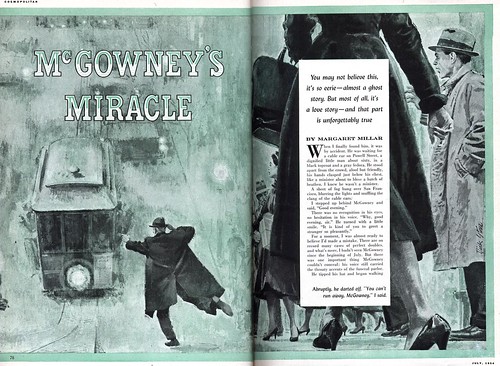We talked for a good 45 minutes... he was pleasantly surprised to hear that there were all sorts of people out here in the world discovering his artwork of long ago. Because I am terrible at shorthand, I will have to paraphrase as much as I can recall of what Dick told me. Hopefully I'll keep my facts straight.

Dick said that this assignment you see here today, from the July 1954 issue of Cosmopolitan, was his 'big break'. He had previously illustrated a children's book called "The Littlest Steam Shovel". Stone's uncle had met someone high up at Grosset and Dunlap and introduced them to his young nephew, who was a fresh from art college. "Suddenly, as far as I was concerned, I was a hotshot children's book illustrator," says Dick today. "So when they offered me three hundred dollars to illustrate the book I countered that I would rather take a percentage of sales."
The publisher suggested that Stone could take the three hundred dollars or nothing. "I took the $300," says Dick with a chuckle.
At that time, Dick was a big fan of the work of William Golden, who was both art directing and illustrating ads for CBS radio. Stone's portfolio was replete with stylized work modelled after Golden's... and not of the more literal type that we have seen this week. But when he was unable to land more assignments, he reworked his portfolio and came to New York to find a rep. He found one fairly quickly in Neeley and Associates, and this assignmet from Cosmo represents the beginning of that long association.

I asked Dick if he also began getting advertising assignments and he replied that first came the magazine work - then later, once you had established a bit of a name by way of your editorial work, the advertising clients took notice. This jibes well with the policy we know existed at the Chares E. Cooper studio, where Cooper encouraged his artists to do editorial (assignments from which the studio took no commision), knowing that the more lucrative advertising assignments would soon follow once an artist's name began to figure prominently in the popular magazines.

By today's standards, even editorial illustration paid pretty well: Dick recalls that most of the major magazines he did work for during the 50's paid between seven or eight hundred to a thousand dollars for a spread. "The 50's," says Stone, "was a great time to be an illustrator."
* I'll have more from my conversation with Dick Stone tomorrow.
My Dick Stone Flickr set.
This Dick Stone is amazing! I what beautiful lines and constricted use of color.
ReplyDeleteSincerely,
Melissa Rioux
junglerioux.blogspot.com
melissarioux.com